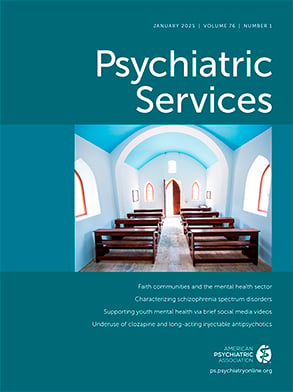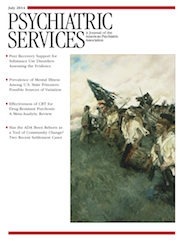Peer Recovery Support for Individuals With Substance Use Disorders: Assessing the Evidence
Abstract
Objective
Methods
Results
Conclusions
About the AEB Series
| Feature | Description |
|---|---|
| Service definition | Peer recovery support is a set of nonclinical, peer-based activities that engage, educate, and support individuals as they make life changes necessary to recover from substance use disorders or co-occurring substance use and mental disorders. In general, peer services offer support in four areas: emotional, informational (for example, skill building), instrumental (for example, assistance with specific needs), and affiliational (for example, social connectedness and inclusion). Peer recovery support providers act as recovery and empowerment catalysts, guiding the recovery process and supporting the individual’s goals and decisions. The activities that constitute this service are education and coaching. |
| Service goals | Self-empowerment; abstinence or decreased substance use; improved quality of life, self-esteem, and sense of purpose; increased social connectedness; improved education, employment, housing, and relationships; decreased criminal justice involvement; improved set of resources to achieve and maintain a life in recovery |
| Populations | Adults with alcohol- and drug-related substance use disorders |
| Settings for service delivery | Services are offered before, during, after, and in lieu of treatment, so settings vary. |
Description of peer recovery support services
Methods
Search strategy
Inclusion and exclusion criteria
Strength of the evidence
Effectiveness of the service
Results
Level of evidence
| Study | Design and population | Peer coach intervention | Outcomes measured | Summary of findings |
|---|---|---|---|---|
| RCTs | ||||
| Bernstein et al., 2005 (20) | Peer-delivered brief motivational intervention plus written advice plus referral list of treatment options versus written advice plus referral list; N=1,175 users of cocaine or heroin from hospital walk-in clinics | Peer-delivered one-to-one brief motivational intervention, with telephone booster at 10 days. Peers were experienced outreach workers in recovery from substance use disorders. Peer adherence to the intervention was assessed in several ways. | Substance use, readiness to change, ASI, contact with the substance use treatment system | At 6 months, the intervention group had a greater proportion of participants with cocaine abstinence (p<.05) and heroin abstinence (p<.06) and who were drug-free (p<.06). No group differences were noted in detox or treatment admissions among those who were abstinent. The intervention group showed a trend for greater improvement in ASI drug severity scores (p<.07) and medical severity scores (p<.06). Some baseline differences in comparison groups were noted. |
| Tracy et al., 2011 (21) | Treatment as usual versus treatment as usual plus DRT plus MAP-Engage versus treatment as usual plus MAP-Engage; N=96 veterans (nearly all male) recruited from inpatient programs for substance use or for psychiatric treatment, where study-related treatment began | MAP-Engage: peer mentor, open-ended individual contact and peer-led groups; escort to first outpatient program; community reinforcement approach. Paid peer mentors were referred by a physician or clinician and supervised by professional staff; mentors had prior experience with a substance use disorder but were abstinent at 6 months. | Postdischarge treatment attendance | Compared with treatment as usual only, treatment as usual plus MAP-Engage alone, and treatment as usual plus DRT plus MAP-Engage were associated with increased adherence to postdischarge outpatient appointments for substance use treatment, general medical, and mental health services (p<.05 for substance use treatment and p<.05 for all appointments combined). |
| Quasi-experimental designs | ||||
| Sanders et al., 1998 (24) | Peer counselors (for pregnant women) versus traditionally trained counselors (for nonpregnant women); N=94 women in recovery from crack cocaine addiction, some of whom were mandated to treatment. Comparison groups were nonequivalent in the number of participants who were pregnant versus nonpregnant. | SISTERS peer counseling comprehensive case management: substance use counseling, prenatal care, support groups, housing, transportation, parenting, nutrition, and assistance with social services. Peers were women in recovery for ≥1 year. Professionals administered 3 months (and then ongoing) of training about substance use disorders. It was unknown whether peer counseling was provided individually or in group settings or both. | Consumer satisfaction overall, program met needs, program met expectations | No group differences were noted for met needs or for reports that a staff member understood them. The intervention group reported higher satisfaction with specific services (p<.05), reported the counselor as the most helpful component (p<.05), and reported counselors as empathic and caring (significance level not reported). More participants in the comparison group reported that the counselor had knowledge of substance use disorders (significance level not reported). |
| Min et al., 2007 (17) | FC and ICM versus ICM only; N=484 people with co-occurring serious mental illness and substance use disorders who had been hospitalized in the prior 2 years | FC paired consumers one to one with peers for community activities, recreation, and self-help; aimed to enhance social network and social support. Peers were abstinent ≥3 years and successfully coping with their mental health issues. | Inpatient psychiatric hospitalization within 3 years | Rehospitalization patterns were significantly different. Survival analysis showed a more gradual slope for FC plus ICM than for ICM only (p<.05); thus consumers had more days in the community before rehospitalization. FC participants had a higher overall probability of remaining in the community (p<.05). |
| Mangrum, 2008 (23) | ATR and substance use treatment versus substance use treatment for consumers involved in criminal justice system but not ATR or for consumers not involved in the justice system; N=4,420 consumers with substance use disorders referred from drug courts, probation, or child protective services | Texas ATR: recovery support services (individual peer coaching, groups, and marital and family counseling) in combination with substance use treatmentb | Substance use treatment completion | For consumers in ATR, treatment completion was associated with recovery support services (p<.001) but not social support services (for example, transportation). Consumers in ATR had better outcomes if drug court or probation was involved (p<.001). |
| Deering et al., 2011 (22) | Used MAP versus did not use MAP; N=242 female street-based sex workers who used drugs | MAP: peer-led mobile outreach drop-in approach; prevention resources; contact point for support, peer interaction, and referral to health, social support, and substance use treatment servicesb | Health and substance use treatment service use, working conditions, violence and safety, sexual and drug-related harms | Over an 18-month period with 479 observations, 42% of surveys across time points reported peer-led MAP use by study participants. When the analysis adjusted for covariates, MAP was positively correlated with inpatient substance use treatment (p<.001). |
| Pre-post service designs | ||||
| Boyd et al., 2005 (25) | N=13 women with substance use disorders and HIV from a rural setting | Peer counseling one-to-one intervention for substance use disorders; emotional and informational support to develop motivation to change substance use and to develop coping strategies for substance use and HIV | Substance use, substance abuse, and consequences; stages of change; loss of control; self-advocacy | When compared with pretreatment measures, the intervention was associated with increased recognition of substance use as a problem (20% to 40% increase), beginning to change substance use (25% to 42%), fewer substance use consequences (varied by subscale), and slightly increased control of substance use (varied by subscale). Significance levels were not reported. |
| Boisvert et al., 2008 (9) | N=18 people in recovery from addiction in a permanent supported housing program | PSC: focus on occupation via handouts and readings; group interventions focused on leadership, group communication, and group facilitation | Relapse rates, perceived community affiliation, supportive behaviors, self-determination, quality of life | Significant positive pre-post treatment changes were noted for social support (p<.05), and positive but nonsignificant changes were noted for quality of life. Relapse was reduced (24% versus 7%, significance not reported) in the year after PSC, and qualitative findings of support and appreciation of PSC goals were reported. |
| Andreas et al., 2010 (16) | N=509 people from Los Angeles in recovery from addiction who had been incarcerated and their families and significant others | PROSPER: peer coach, role models, social opportunities, and health and wellness services; “skills to prosper”: job search resources, workshops, peer coaching, and leadership opportunities. Individual and group peer activitiesb | Self-efficacy, perceived social support, personal feeling, perceived stress, quality of life | One-year “significant and positive changes” from baseline were reported (no data were shown) for self-efficacy, social support, quality of life, and perceived stress. Peer and staff accessibility were valued. Staff size, hours of operation, and distance from home or work were viewed as negative aspects of the program. |
| Armitage et al., 2010 (14) | N=152 people in recovery from addiction and their families | RAP: recovery center with drop-in resource center, clean-and-sober social and recreational activities, and self-help meetings; café and job training program for peers; leadership training for civic engagement of people in recoveryb | Substance use, consumer satisfaction, progress toward RAP’s goals | At 6 months, 86% of participants indicated no use of alcohol or drugs in the past 30 days, and another 4% indicated reduced use (pretreatment data were not reported). A total of 95% reported strong willingness to recommend the program to others, 89% found services helpful, and 92% found materials helpful. |
Effectiveness of the service
RCTs.
Quasi-experimental studies.
Pre-post service designs.
Discussion
Conclusions
Evidence for the effectiveness of peer recovery support for individuals with substance use disorders: moderate
Acknowledgments and disclosures
References
Information & Authors
Information
Published In

Cover: The Nation Makers, by Howard Pyle 1903. Oil on canvas. Collection Brandywine River Museum of Art, purchased through a grant from the Mabel Pew Myrin Trust, 1984.
History
Authors
Metrics & Citations
Metrics
Citations
Export Citations
If you have the appropriate software installed, you can download article citation data to the citation manager of your choice. Simply select your manager software from the list below and click Download.
For more information or tips please see 'Downloading to a citation manager' in the Help menu.
View Options
View options
PDF/EPUB
View PDF/EPUBLogin options
Already a subscriber? Access your subscription through your login credentials or your institution for full access to this article.
Personal login Institutional Login Open Athens loginNot a subscriber?
PsychiatryOnline subscription options offer access to the DSM-5-TR® library, books, journals, CME, and patient resources. This all-in-one virtual library provides psychiatrists and mental health professionals with key resources for diagnosis, treatment, research, and professional development.
Need more help? PsychiatryOnline Customer Service may be reached by emailing [email protected] or by calling 800-368-5777 (in the U.S.) or 703-907-7322 (outside the U.S.).
